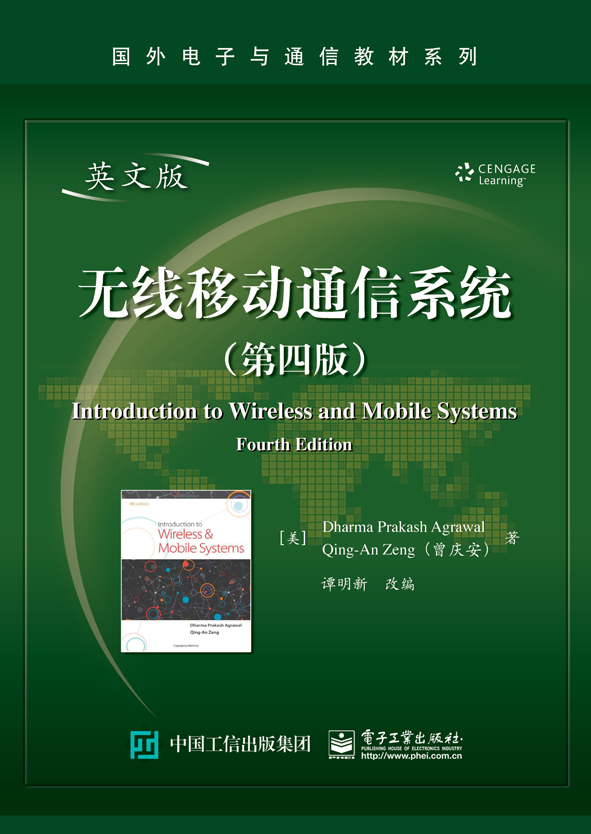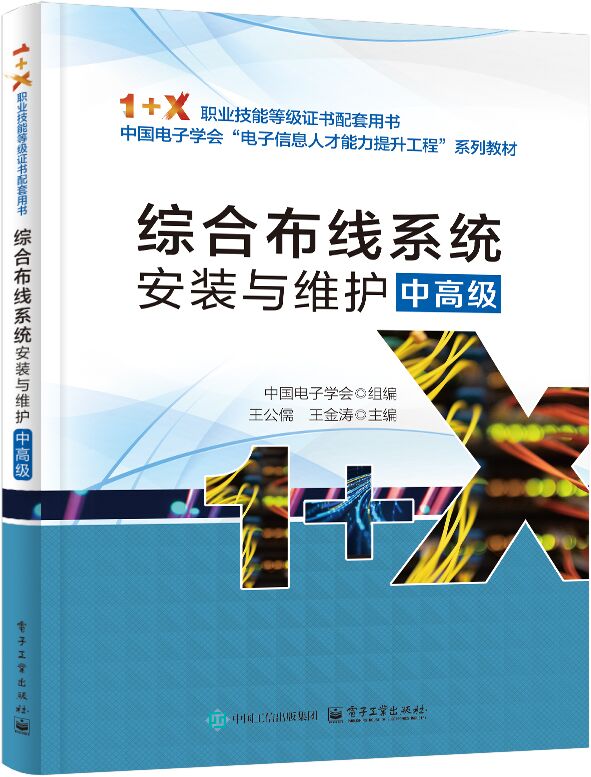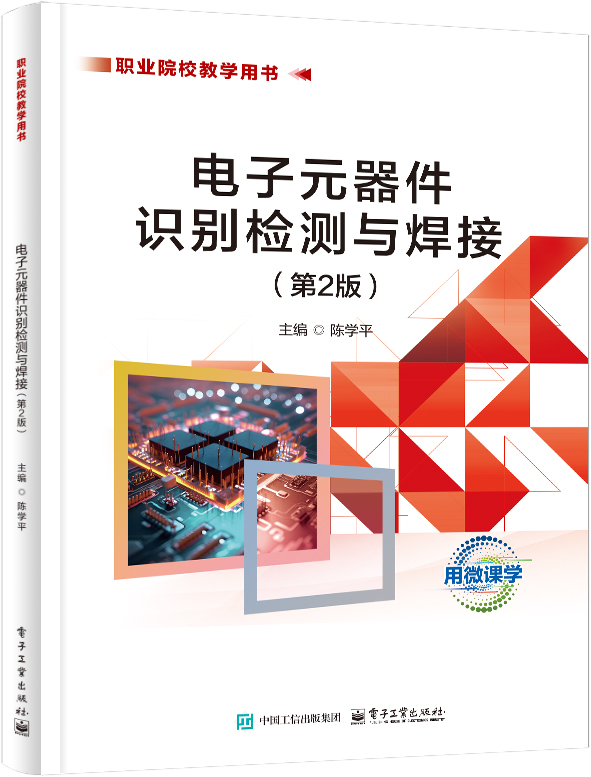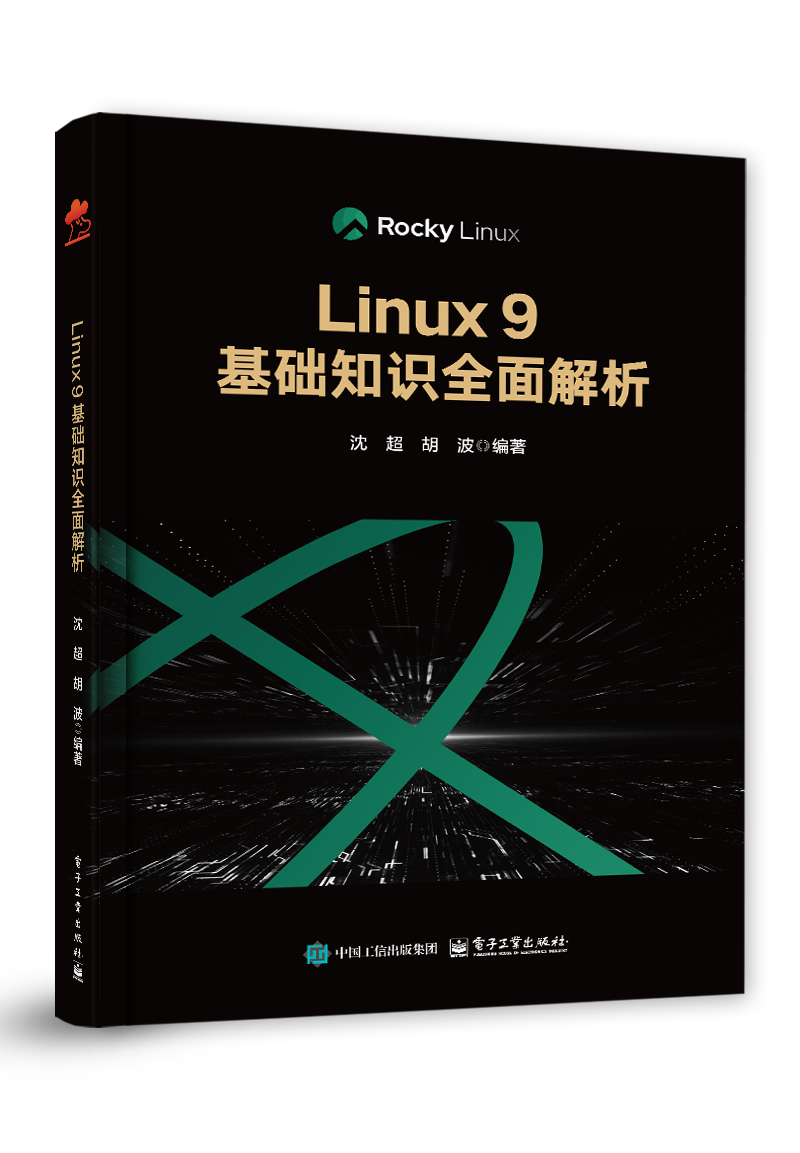无线移动通信系统(第四版)(英文版)
丛 书 名:
国外电子与通信教材系列
作 译 者:谭明新
出 版 日 期:2016-04-01
书 代 号:G0285130
I S B N:9787121285134
图书简介:
本书向授课教师提供英文原版教辅(习题解答,其他资源),具体申请方式请咨询te_service@phei.com.cn。本书系统、全面地介绍了无线移动通信的基本理论,分析了无线移动通信所涉及的各个主题,包括无线移动信号的传输、蜂窝的基本概念、多路无线接入、多址技术、调制技术、信道分配技术、通信系统的设计、网络协议、现有的蜂窝系统、IEEE 802系列技术、Ad Hoc网络与传感器网络、无线网络的安全性与隐私问题、卫星通信系统等。为了加强对书中概念的理解,各章还给出了开拓思维的实验。
定价 89.0
您的专属联系人更多
联系人:马老师
电话:4557
邮箱:malan@phei.com
-
配 套 资 源图书特别说明:本书向授课教师提供英文原版教辅(习题解答,其他资源),具体申请方式请咨询te_service@phei.com.cn。
本书资源
本书暂无资源会员上传本书资源
-
图 书 内 容
内容简介
本书向授课教师提供英文原版教辅(习题解答,其他资源),具体申请方式请咨询te_service@phei.com.cn。本书系统、全面地介绍了无线移动通信的基本理论,分析了无线移动通信所涉及的各个主题,包括无线移动信号的传输、蜂窝的基本概念、多路无线接入、多址技术、调制技术、信道分配技术、通信系统的设计、网络协议、现有的蜂窝系统、IEEE 802系列技术、Ad Hoc网络与传感器网络、无线网络的安全性与隐私问题、卫星通信系统等。为了加强对书中概念的理解,各章还给出了开拓思维的实验。图书详情
ISBN:9787121285134开 本:16开页 数:440字 数:801.0本书目录
目 录 CHAPTER 1 Introduction 1 1.1 History of Cellular Systems 1 1.2 Characteristics of Cellular Systems 12 1.3 Fundamentals of Cellular Systems 15 1.4 Cellular System Infrastructure 21 1.5 Network Protocols 24 1.6 IEEE 802.11 Technologies 24 1.7 Ad Hoc Networks 25 1.8 Sensor Networks 26 1.9 Wireless MANs, LANs, BANs, and PANs 27 1.10 Security and Privacy in Wireless Networks 28 1.11 Satellite Systems 28 1.12 Recent Advances 29 1.13 Outline of the Book 29 1.14 References 30 1.15 Problems 31 Chapter 2 Mobile Radio Propagation 33 2.1 Introduction 33 2.2 Types of Radio Waves 33 2.3 Propagation Mechanisms 34 2.4 Free Space Propagation 35 2.5 Land Propagation 37 2.6 Path Loss 39 2.7 Slow Fading 41 2.8 Fast Fading 43 2.8.1 Statistical Characteristics of the Envelope 43 2.8.2 Characteristics of Instantaneous Amplitude 46 2.9 Doppler Effect 48 2.10 Delay Spread 50 2.11 Intersymbol Interference 51 2.12 Coherence Bandwidth 52 2.13 Cochannel Interference 52 2.14 Summary 53 2.15 References 53 2.16 Experiments 54 2.17 Open-Ended Projects 55 2.18 Problems 55 Chapter 3 Cellular Concept 58 3.1 Introduction 58 3.2 Cell Area 58 3.3 Signal Strength and Cell Parameters 60 3.4 Capacity of a Cell 64 3.5 Frequency Reuse 66 3.6 How to Form a Cluster 67 3.7 Cochannel Interference 70 3.8 Cell Splitting 72 3.9 Cell Sectoring 72 3.10 Summary 75 3.11 References 75 3.12 Experiments 75 3.13 Open-Ended Projects 77 3.14 Problems 77 Chapter 4 Multiple Radio Access 81 4.1 Introduction 81 4.2 Multiple Radio Access Protocols 82 4.3 Contention-Based Protocols 83 4.3.1 Pure ALOHA 84 4.3.2 Slotted ALOHA 85 4.3.3 CSMA 86 4.3.4 CSMA/CD 90 4.3.5 CSMA/CA 91 4.4 Comparison of CSMA/CD and CSMA/CA 95 4.5 Summary 95 4.6 References 95 4.7 Experiments 97 4.8 Open-Ended Projects 98 4.9 Problems 98 Chapter 5 Multiple Division Techniques 100 5.1 Introduction 100 5.2 Concepts and Models for Multiple Divisions 100 5.2.1 FDMA 101 5.2.2 TDMA 103 5.2.3 CDMA 105 5.2.4 OFDM 110 5.2.5 SDMA 112 5.2.6 Comparison of Multiple Division Techniques 113 5.3 Modulation Techniques 114 5.3.1 Amplitude Modulation (AM) 114 5.3.2 Frequency Modulation (FM) 114 5.3.3 FSK 116 5.3.4 Phase Shift Keying (PSK) 116 5.3.5 Quadrature Phase Shift Keying (QPSK) 117 5.3.6 π/4QPSK 117 5.3.7 Quadrature Amplitude Modulation (QAM) 119 5.3.8 16QAM 119 5.4 Summary 120 5.5 References 121 5.6 Experiments 121 5.7 Open-Ended Projects 122 5.8 Problems 122 Chapter 6 Channel Allocation 125 6.1 Introduction 125 6.2 Static Allocation versus Dynamic Allocation 126 6.3 Fixed Channel Allocation (FCA) 126 6.3.1 Simple Borrowing Schemes 127 6.3.2 Complex Borrowing Schemes 127 6.4 Dynamic Channel Allocation (DCA) 130 6.4.1 Centralized Dynamic Channel Allocation Schemes 130 6.4.2 Distributed Dynamic Channel Allocation Schemes 131 6.5 Hybrid Channel Allocation (HCA) 132 6.5.1 Hybrid Channel Allocation (HCA) Schemes 132 6.5.2 Flexible Channel Allocation Schemes 133 6.6 Allocation in Specialized System Structure 133 6.6.1 Channel Allocation in One-Dimensional Systems 133 6.6.2 Reuse Partitioning-Based Channel Allocation 134 6.6.3 Overlapped Cells–Based Channel Allocation 135 6.7 System Modeling 137 6.7.1 Basic Modeling 137 6.7.2 Modeling for Channel Reservation 139 6.8 Summary 140 6.9 References 141 6.10 Experiments 141 6.11 Open-Ended Projects 143 6.12 Problems 143 Chapter 7 Mobile Communication Systems 147 7.1 Introduction 147 7.2 Cellular System Infrastructure 147 7.3 Registration 151 7.4 Handoff Parameters and Underlying Support 153 7.4.1 Parameters Influencing Handoff 153 7.4.2 Handoff Underlying Support 154 7.5 Roaming Support 156 7.5.1 Home Agents, Foreign Agents, and Mobile IP 157 7.5.2 Rerouting in Backbone Routers 159 7.6 Multicasting 161 7.7 Ultra-Wideband Technology 164 7.7.1 UWB System Characteristics 164 7.7.2 UWB Signal Propagation 165 7.7.3 Current Status and Applications of UWB Technology 165 7.7.4 Difference between UWB and Spread Spectrum Techniques 166 7.7.5 UWB Technology Advantages 166 7.7.6 UWB Technology Drawbacks 167 7.7.7 Challenges for UWB Technology 167 7.7.8 Future Directions 168 7.8 Femto Cell Network 168 7.8.1 Technical Features 168 7.8.2 Challenges 171 7.9 Summary 173 7.10 References 173 7.11 Experiments 175 7.12 Open-Ended Problem 176 7.13 Problems 176 Chapter 8 Network Protocols 179 8.1 Introduction 179 8.1.1 Layer 1: Physical Layer 180 8.1.2 Layer 2: Data Link Layer 181 8.1.3 Layer 3: Network Layer 181 8.1.4 Layer 4: Transport Layer 181 8.1.5 Layer 5: Session Layer 181 8.1.6 Layer 6: Presentation Layer 182 8.1.7 Layer 7: Application Layer 182 8.2 TCP/IP Protocol 182 8.2.1 Physical and Data Link Layers 182 8.2.2 Network Layer 183 8.2.3 TCP 185 8.2.4 Application Layer 185 8.2.5 Routing Using Bellman-Ford Algorithm 185 8.3 TCP over Wireless 186 8.3.1 Need for TCP over Wireless 186 8.3.2 Limitations of Wired Version of TCP 187 8.3.3 Solutions for Wireless Environment 187 8.3.4 Link Layer Protocols 189 8.4 Internet Protocol Version 6 (IPv6) 190 8.4.1 Transition from IPv4 to IPv6 190 8.4.2 IPv6 Header Format 192 8.4.3 Features of IPv6 192 8.4.4 Differences between IPv6 and IPv4 193 8.5 Summary 193 8.6 References 193 8.7 Experiment 195 8.8 Open-Ended Project 195 8.9 Problems 196 Chapter 9 Existing Wireless Systems 198 9.1 Introduction 198 9.2 AMPS 198 9.2.1 Characteristics of AMPS 199 9.2.2 Operation of AMPS 199 9.2.3 General Working of AMPS Phone System 202 9.3 IS-41 203 9.3.1 Introduction 203 9.3.2 Support Operations 205 9.4 GSM 205 9.4.1 Frequency Bands and Channels 206 9.4.2 Frames in GSM 208 9.4.3 Identity Numbers Used by a GSM System 209 9.4.4 Interfaces, Planes, and Layers of GSM 211 9.4.5 Handoff 213 9.4.6 Short Message Service (SMS) 214 9.5 IS-95 214 9.5.1 Power Control 217 9.6 IMT-2000 219 9.6.1 International Spectrum Allocation 220 9.6.2 Services Provided by Third-Generation Cellular Systems (3G) 220 9.6.3 Harmonized Third-Generation Systems 221 9.6.4 Multimedia Messaging Service (MMS) 222 9.6.5 Universal Mobile Telecommunications System (UMTS) 223 9.7 Summary 227 9.8 References 228 9.9 Problems 228 Chapter 10 IEEE 802.11 Technologies and Access Points 230 10.1 Introduction 230 10.2 Downlink Transfer of Information 231 10.3 Uplink Transfer of Information 235 10.3.1 Uplink Transfer of Information with RTS/CTS 235 10.4 Variants of 802.11 Series Protocols 238 10.4.1 IEEE 802.11b 239 10.4.2 IEEE 802.11g 240 10.4.3 IEEE 802.11n 240 10.4.4 IEEE 802.11ac 241 10.5 WiFi Access in Airplanes 243 10.6 Summary 244 10.7 References 244 10.8 Experiment 245 10.9 Open-Ended Project 245 10.10 Problems 245 Chapter 11 Ad Hoc Networks 247 11.1 Introduction 247 11.2 Characteristics of MANETs 249 11.3 Applications 250 11.4 Routing 251 11.4.1 Need for Routing 251 11.4.2 Routing Classification 252 11.5 Table-Driven Routing Protocols 253 11.5.1 Destination-Sequenced Distance-Vector Routing 253 11.5.2 Cluster Formation in a MANET 254 11.5.3 Cluster Head Selection 254 11.5.4 Cluster Head Gateway Switch Routing 254 11.5.5 Wireless Routing Protocol 256 11.6 Source-Initiated On-Demand Routing 257 11.6.1 Ad Hoc On-Demand Distance Vector Routing 257 11.6.2 Dynamic Source Routing 258 11.6.3 Temporarily Ordered Routing Algorithm (TORA) 260 11.6.4 Associativity-Based Routing 262 11.6.5 Signal Stability-Based Routing 263 11.7 Hybrid Protocols 264 11.7.1 Zone Routing 264 11.7.2 Fisheye State Routing 265 11.7.3 Landmark Routing (LANMAR) for MANET with Group Mobility 265 11.7.4 Location-Aided Routing 266 11.7.5 Distance Routing Effect Algorithm for Mobility 267 11.7.6 Relative Distance Microdiscovery Ad Hoc Routing (RDMAR) 268 11.7.7 Power Aware Routing 268 11.8 Multipath Routing Protocols 269 11.8.1 On-Demand Multipath Routing for Mobile Ad Hoc Networks 270 11.8.2 Ad Hoc On-Demand Distance Vector–Backup Routing (AODV–BR) 271 11.8.3 Split Multipath Routing 273 11.8.4 Caching and Multipath Routing Protocol 273 11.8.5 Neighbor-Table-Based Multipath Routing in Ad Hoc Networks (NTBMR) 276 11.9 Vehicular Area Network (VANET) 277 11.10 Network Simulators 280 11.10.1 ns-2 and ns-3 280 11.10.2 Other Network Simulators 282 11.11 Summary 283 11.12 References 283 11.13 Experiments 287 11.14 Open-Ended Project 289 11.15 Problems 289 Chapter 12 Sensor Networks 293 12.1 Introduction 293 12.2 Network Characteristics 297 12.2.1 Classification of Sensor Networks 297 12.2.2 Fundamentals of MAC Protocol for WSNs 298 12.2.3 Flat Routing in Sensor Networks 299 12.2.4 Directed Diffusion 299 12.2.5 Sensor Protocols for Information via Negotiation (SPIN) 300 12.2.6 COUGAR 300 12.3 Hierarchical Routing in Sensor Networks 301 12.3.1 Cluster-Based Routing Protocol (CBRP) 303 12.3.2 Low-Energy Adaptive Clustering Hierarchy (LEACH) 303 12.3.3 Threshold-Sensitive Energy-Efficient Network (TEEN) 304 12.3.4 Adaptive Periodic Threshold-Sensitive Energy-Efficient Sensor Network(APTEEN) Protocol 305 Chapter 13 Wireless LANs, PANs, BANs, and MANs 308 13.1 Introduction 308 13.2 ETSI High-Performance LAN (HiperLAN) 308 13.3 HomeRF 310 13.4 Ricochet 312 13.5 Wireless Personal Area Networks (WPANs) 313 13.6 IEEE 802.15.1 (Bluetooth) 314 13.6.1 Architecture of the Bluetooth System 317 13.6.2 IEEE 802.15.3 320 13.6.3 IEEE 802.15.4 322 13.7 ZigBee 328 13.8 Wireless Body Area Networks (WBANs) 329 13.9 WMANs Using Worldwide Interoperability for Microwave Access (WiMAX) 330 13.9.1 MAC Layer 330 13.9.2 MAC Layer Details 331 13.9.3 Service-Specific Convergence Sublayers 331 13.9.4 Common Part Sublayer 331 13.9.5 Physical Layer 335 13.9.6 Physical Layer Details 336 13.10 WMAN Using a Mesh Network 337 13.11 WMANs using 3GPP and Long Term Evolution (LTE) 340 13.12 WMAN Using Long Term Evolution (LTE) and LTE-A 343 13.13 Summary 346 13.14 References 347 13.15 Experiments 349 13.16 Open-Ended Project 350 13.17 Problems 351 Chapter 14 Security and Privacy in Wireless Networks 354 14.1 Introduction 354 14.2 Encryption and Decryption Techniques 354 14.2.1 Encryption Techniques 355 14.3 Wireless System Security 358 14.3.1 Security in Cell Phones 360 14.3.2 Security in LTE Networks 360 14.3.3 Authentication in WiFi-based AP Networks 361 14.3.4 Diffie-Hellman Protocol 364 14.3.5 Elliptic Curve Cryptography (ECC) 365 14.4 Firewalls and System Security 366 14.5 Security Issues in Mobile Ad Hoc Networks (MANETs) 367 14.5.1 Security Approaches 369 14.5.2 Intrusion Detection 369 14.5.3 Requirements for an IDS for MANETs 370 14.5.4 Mobile Agents for Intrusion Detection and Response in a MANET 372 14.5.5 Intrusion Detection Architecture (IDA) Based on a Static Stationary Database (SSD) 373 14.5.6 Cluster-Based Intrusion Detection System in MANETs 374 14.5.7 Logging Module 376 14.5.8 Selfishness in a MANET 377 14.6 Secured Communication in Wireless Sensor Networks (WSNs) 377 14.6.1 Shared Symmetric Key between Two Sensors in a Randomly Deployed WSN 379 14.6.2 Use of Bivariate Polynomial in Establishing a Shared Secret Key between Two Sensors 382 14.6.3 Intrusion Detection Schemes 382 14.7 Distributed DoS (DDoS) Attack Detection 386 14.7.1 Covariance Analysis Method 388 14.8 Summary 391 14.9 References 392 14.10 Experiments 396 14.11 Open-Ended Project 397 14.12 Problems 397 Chapter 15 Satellite Systems 401 15.1 Introduction 401 15.2 Types of Satellite Systems 401 15.3 Characteristics of Satellite Systems 406 15.4 Satellite System Infrastructure 408 Acronyms 411展开前 言
导 读 击鼓传信是最早、最方便的通信方式,非洲人用圆木特制的大鼓所发出的声音可以传3~4公里远,再通过“鼓声接力”和专门的“击鼓语言”,可以在很短的时间内把消息准确地传送到50公里以外的另一个部落。这时利用了无线通信的如下基本原理:①信号的频率越低,衰减越小;②无线信号的中继与无失真传输;③通信信令;④无线传输存在明显的时延。电子通信出现以来,一直占据主导地位的有线通信如今部分被无线移动通信取代的根本原因是:在寻常百姓完全能够支付通信费用的条件下,无线移动通信基本实现了在“任何时候”可以与“任何地方”的“任何人”进行可靠的通信。换言之,与有线通信相比,移动通信更简便、快捷。 移动通信的本质特征是:双方进行通信时,至少有一方(或者双方)可以处于移动中。这时,通信过程中的两个核心问题即带宽问题和噪声问题尤其突出,体现在:①在有限范围内,采用的频率资源为一次性资源;②无线多径传输导致接收端的载噪比迅速下降。1G至4G的历次演变都大大提高了这两项指标。如今即将面临的5G如何持续提高这两项指标,拭目以待。 国内移动通信方面的教材所涉及的技术仅限于1G至3G系统与技术的完整介绍,引进版教材也至少是8~9年前出版的。可近些年来,无线移动通信的概念与范围进行了延伸,多项无线技术进入了或者正在进入商业应用,而国内却没有相关背景与知识的图书。电子工业出版社引进的Introduction to Wireless and Mobile Systems,Fourth Edition正好弥补了这一缺憾。该书在介绍常规无线移动通信(包括无线信道的传输特性、信道分配、多址技术、现有的无线系统)的基础上,还具有如下特点: ? 与日益增长的应用相适应,增添了IEEE 802.11技术与接入点、自组织网络、传感器网络、安全性与隐私等的完整介绍,且各自独立成章。本书以较大的篇幅介绍了这些新型技术的基本原理与应用实例。 ? 目前在国内,无线通信课程的实验器材基本上都是实验箱,完成简单的连接关系后接通电源即可观测到无线通信过程的基本指标,学生总像是局外人。与传统实验不同的是,本书每章给出的实验灵活多样,学生需要通过自己设计、编程、搭建模块等方式,才能观测到无线通信过程的各种现象与结果,这里的关键是,学生本人是实验的设计者、组织者和执行者。 ? 本书每章增加了开放性项目,让学生自己开发解决问题的途径,其中有些问题是领域内悬而待决的问题。因此,只有几行字的开放性项目有可能激发学生的研究兴趣。 ? 书中还介绍了通信问题(如原子钟)的基本知识、一些较新的观点与应用(如无线对讲机正在融入无线通信网)等。 考虑到国内读者的阅读习惯,为了让学生抓住重点,并有针对性地提高,本英文改编版删除了原著的部分章节,删除的内容如下:①第2章“概率、统计与话务理论”;②第4章“信道编码与差错控制”;③第14章“传感器网络”的部分内容;④第17章“卫星系统”的部分内容;⑤第18章“无线技术的最新进展”;⑥附录之爱尔兰B表、附录之索引。 删除正文中②③的原因是读者已经系统地学习过这两门课程;保留了④⑤传感器网络、卫 星系统的最基本的内容,从事这类工作的读者可以参考更专业、更全面的文献。 本书的中文版为英文原版的完整翻译,没有删除任何内容。感兴趣的读者可参考中文版。 本书的教辅包括习题解答和PPT,采用本书作为教材的教师可通过邮箱te_service@phei.com.cn 申请获得。 谭明新 于武汉展开作者简介
本书暂无作者简介 -
样 章 试 读
-
图 书 评 价 我要评论









